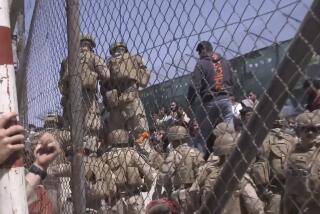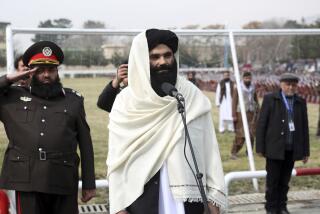A Ragtag Army Rallies With Words, Weapons
- Share via
GULBAHAR, Afghanistan — Anti-Taliban forces staged a brief mock assault on a barren hillside Monday after their leader told the soldiers they were the world’s last hope in the war to end terrorism here.
“Now all the world is focusing on you,” Burhanuddin Rabbani, the Northern Alliance’s figurehead leader, told about 2,000 of his troops. “They are hopeful that your struggle to eradicate the terrorist havens and secure peace in your country will continue bravely and succeed as soon as possible.
“If you don’t do this, no other source, no other country, will be able to fight this problem,” added Rabbani, the former--and, according to supporters, current--president of Afghanistan. “It is only you, and again it is only you, who can kill this danger in the region.”
As Rabbani addressed his troops--a poorly armed and equipped collection of professional soldiers and part-time warriors who farm or do odd jobs when not at the front--a U.S. B-52 bomber struck Taliban targets on the plains in the distance.
The airstrike, in the already heavily bombed area near the Taliban-held village of Aster Gache, seemed coordinated with the alliance’s military maneuvers. The exercise, held after two days of practice, was designed to support the opposition’s claim that it is ready for an offensive against Kabul, the Afghan capital, about 40 miles south of here.
Minutes after the opening speeches began, the B-52 flew directly over the training ground and made at least four runs, dropping three huge bombs and a stream of smaller ones in 45 minutes.
The attack was the only daylight airstrike near the front lines north of Kabul, and it followed an even quieter Sunday in the area.
But U.S. warplanes were in action Monday in several other areas of Afghanistan, opposition forces said, including about 30 miles northeast of Taloqan, the seat of Rabbani’s government until the Taliban seized the city last year.
There was no sign Monday that Northern Alliance forces were making significant gains toward Taloqan or the strategic northern city of Mazar-i-Sharif. But Rabbani and his commanders continue to hint that they may soon launch assaults on probably the most difficult front of all: the Taliban positions defending Kabul.
“We are hopeful that as soon as possible all the nation will be saved from filthy terrorists,” Rabbani told his troops. “The day is near. I want your success from God in every field and battle of your jihad [holy struggle].”
Rabbani, who has a degree in theology and was a professor of Islamic law at Kabul University, was elected in 1992 as Afghanistan’s interim president by an executive council of the seven factions of moujahedeen that fought the Soviet occupation.
But he refused to step down when his term was up, and factional fighting in Kabul intensified. An estimated 50,000 people died in several years of warfare until the Taliban restored a harsh peace by driving out Rabbani’s government in the fall of 1996.
The United Nations still recognizes Rabbani and his government as the legitimate rulers of Afghanistan, but his Northern Alliance is dominated by minority Tajiks, Uzbeks and Hazaras and has little support among Pushtuns, who make up about 40% of the population.
But as U.S.-led efforts to foment a Pushtun uprising against the Taliban falter, Washington is providing increasing support to the Northern Alliance in the hope that the opposition force can win a ground war against the regime without the help of a large number of U.S. troops.
Meanwhile, Rabbani’s foreign minister, Abdullah, confirmed that eight men who landed over the weekend at a desert airstrip about 40 miles northeast of Kabul were Americans who came to inspect the runway, which is under construction.
Although Abdullah, who goes by one name, repeatedly has said that the runway is being built to bring in humanitarian relief, he admitted the obvious to reporters Monday: It could also be used for the delivery of military supplies, which the Northern Alliance desperately needs if it is to launch an offensive on Kabul.
In the guessing game over the quality and cohesion of the alliance’s forces, every possible clue is being scrutinized. Some here saw significance in the fact that Rabbani’s top commander, Gen. Mohammed Qassim Fahim, did not address the troops at Monday’s ceremony.
Fahim replaced the legendary opposition commander Ahmed Shah Masoud, a hero of the war against Soviet occupation in the 1980s and of less successful battles against the Taliban. Masoud was assassinated by two Arabs posing as television journalists.
The Northern Alliance blames the killing of Masoud, which occurred just days before the Sept. 11 attacks in the United States, on Afghanistan-based militant Osama bin Laden. U.S. officials regard Bin Laden, who has deep ties with the Taliban, as the prime suspect behind the Sept. 11 attacks.
So far, Fahim hasn’t shown the power to inspire soldiers and command a disparate and often fractious group of commanders--a power Masoud demonstrated time and again.
Fahim, who was Masoud’s intelligence and security chief, remained silent on the reviewing stand, which was fashioned out of truck trailers decorated with green banners honoring the slain guerrilla chief. The general left it to his chief of staff, Bismullah Khan, to speak. Khan did little more than explain which units provided the soldiers on parade in front of him.
Rabbani, whose political clout had declined sharply as Masoud asserted his own power in recent years, delivered what seemed an uninspiring speech to the troops Monday during which he frequently repeated himself.
“Your jihad, your resistance, has finally succeeded with your manly courage, sacrifice and historic benevolence, and with the help of your brave brothers and sisters,” Rabbani said.
After he finished speaking, a soldier from the alliance’s Mohammed Division began a poetry reading. When he was in mid-verse, a recoilless rifle opened fire with a resounding bang several minutes before cue.
It was aiming at a small stone bunker built on an empty hill as a target for the military exercise, which was a training assault on two mock Taliban positions involving no more than a few dozen of the alliance soldiers present.
The rifle continued to shell the hillside as eight armored personnel carriers advanced in pairs, firing cannons and machine guns as they went. Within a half-hour, the soldiers had achieved their objective, and the troops left without a final word from their leaders.
Dozens of tanks, armored vehicles, multiple-rocket launchers and other Soviet-era military hardware--including a large Luna rocket on a trailer--headed back toward the front line, where the alliance troops may soon be locked in real combat with the Taliban.
One of the aging T-54 tanks stalled in the middle of the main road heading south toward Kabul. The soldiers riding on top jumped down and walked toward the front.
More to Read
Sign up for Essential California
The most important California stories and recommendations in your inbox every morning.
You may occasionally receive promotional content from the Los Angeles Times.













